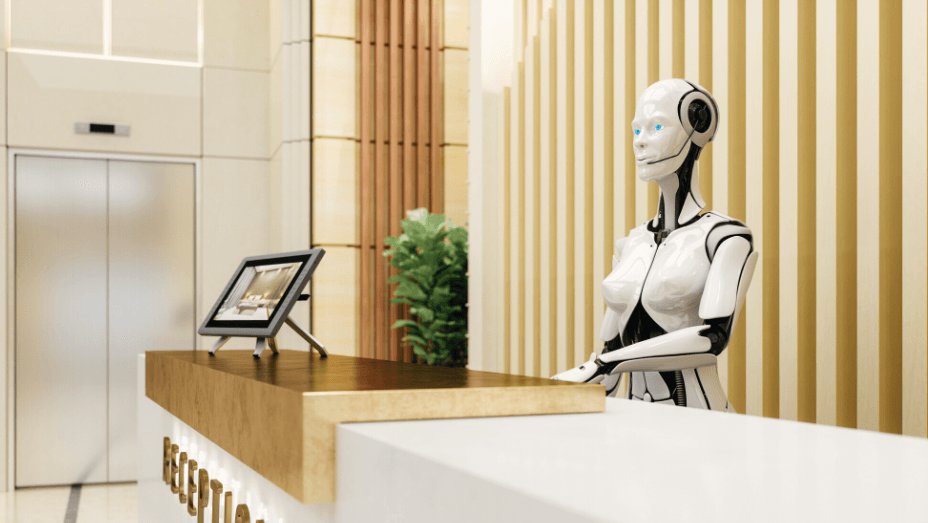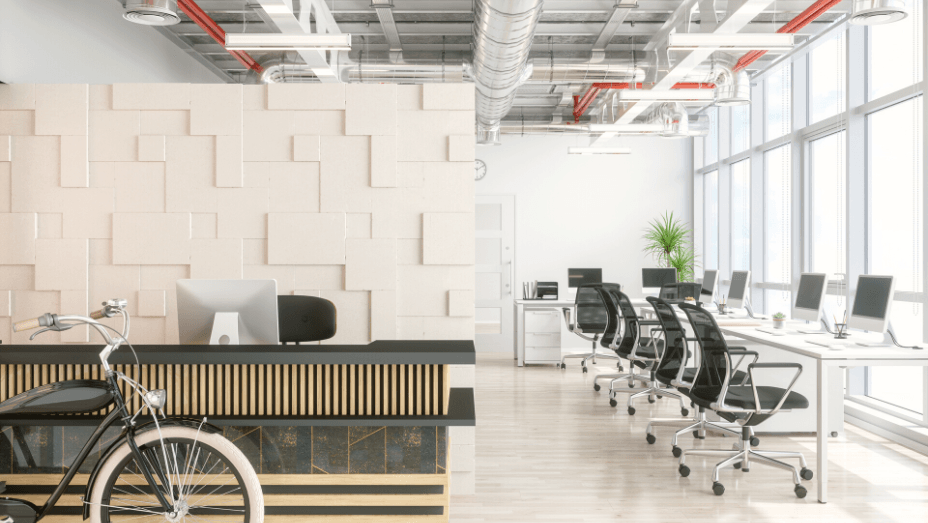How do you make sure your receptionist area communicates your message clearly? That it paves the way nicely to your job interviews or other in-person business meetings?
Here’s the scenario you’ll need to consider:
A job candidate/potential client walks into a bar your office reception office for the first time… And it’s right there, in your reception area, that you start delivering the visitor experience.
To send out the message you want to send.
That you’re trustworthy and competent. Innovative and inspiring. Whatever values and characteristics you want visitors to associate your company with.
And these are the key elements you’ll want to focus on to make sure you’ll make a good impression in your office reception area…
Your Brand Starts Here or Why Is Your Office Reception Area So Important
For yes, your reception area speaks more of your company’s brand than you might think. It’ll deliver that powerful immediate, almost visceral experience to your first-time visitors that will either make or break their first impression of your company.
Now, here are 5 steps to take to make sure your reception area aligns with your brand. And that it sends out the right message to your visitors from the very beginning:
1. It Helps You Leave a Strong First Impression
The moment a visitor steps into your office reception room he/she starts making assumptions.
If, for instance, the receptionist area is clean and clutter-free, the potential business associate/new client/future employee will use it to make an assumption about the way you run your business.
Or, if the reception area is welcoming and comfortable or maybe eclectic and creative, job candidates will immediately see it as an extension of your workspace.
And they’ll start making assumptions about what’d be like to work there.
See? You can “use” that first impression that your office reception area leaves on your visitors as an opportunity to communicate whatever you wish to communicate to them.
Or you can just let it go to waste…
2. It’s the Face of Your Company
Is it a friendly face? A face that a new visitor would trust? Does it convey competence?
The waiting area is the public face of your company — the very first point of contact for your new clients/new employees with your business.
And, if designed right, it’ll help you guide their first assumptions towards your company: that it’s trustworthy, competent, efficient…
3. It’s the Link Between You and Your Business Partners/New Staff Members
The positive experience starts here, at the office reception desk. And also all your business relations.
Take your office reception area as your company’s “opening act”. If it fails to impress, stir curiosity, and set a solid foundation for your future business relationships, visitors might lose interest in seeing the rest.
As visitors — potential clients, business associates, and new staff members — will start making assumptions and forming opinions the minute they set foot into the lobby. This is where you start building your business relationships with them.
Where you gain or lose their trust.
And you’ll want to make sure you start on the right foot with your new business partners.
4. It Helps You Communicate a Positive Image of Your Brand
If designed properly, this space in your building will help you tell that story about your brand that you want your visitors to know. The idea is to claim this space and send out your message.
Instead of leaving it up to them entirely to make their own right or wrong first assumptions about your brand values and office culture.
Use this room in your facility to your advantage and make sure it communicates, properly, what you do, and what your brand is truly about. Tie it to those values that you want your brand to be associated with, like competency or boldness.
5. It’s Where Visitors Get to Learn More About Your Company
Another opportunity you’ll want to make the most of.
As visitors are waiting in your office reception area, give them the chance to learn more about your company’s background and culture.
And pave the way smoothly to the business meetings and job interviews that’ll take place next.

Past, Present, and Future of Office Reception Desks
OK, now that you know what a crucial role your office reception area plays in leaving a lasting first impression on your visitors. And you might just wonder how businesses have, are, and will be designing their reception areas.
Let’s take a retrospective look at how they used to look and the current trends in designing office receptions.
Then, let’s try and speculate on the future ones you should expect.
Office Reception Areas in the Past
Reception desks located in large, open-plan office areas, used to be a thing in the ‘80s and ‘90s. Just think of the receptionist area in the “The Office” TV series.
Can you already picture the welcome sign and the company logo on the reception area's back wall?
As for the reception seating, generic plastic chairs used to be acceptable back then. Pair them with a few magazines and you get the “waiting room” style office reception area of those years.
Luckily, the 2000s came with some much-needed upgrades.
Office Reception Areas Today
Today, companies are much more aware of the fact that their reception areas can influence visitors’ perceptions of them.
Therefore, they put a lot more focus on comfort. On always having someone friendly and professional looking at the front desk to welcome visitors.
On strategically displaying company branding and simply owing the place to send a clear message.
The generic magazines have been replaced with leaflets to read, where visitors can learn more about the company.
And office reception rooms have been upgraded from generic “waiting rooms”, whose only roles used to be that of welcoming visitors, to crucial areas in companies’ office buildings.
Whose role is to welcome visitors AND communicate to them what those businesses are all about.
What their values are and what they stand for.
Office Reception Areas in the Future
What should you expect from the years to come in terms of office reception design trends?
(Even) more ergonomic furniture, more metal, sleeker lines, and more high-tech incorporated into the overall design.
And yes, you can dare think… robots in the reception areas, too.

Most Common Office Reception Problems
The annual 'Office Worker Bugbears' survey conducted by Proxyclick and including 2,000 U.S. and UK office workers, revealed that:
- Over 71% of the surveyed office workers found unfriendly receptionists to be the no. 1 cause of bad reception area experience
- Over 53% of them stated that a lackluster welcome was a key reason for the negative first impression they formed of a company right in its lobby area
Before you start making any adjustments to your office reception desk, you need to know the most common reasons for a bad visitor experience.
So you know what you should be focusing on in the first place.
Here’s a top 5 office reception issues to put at the top of your list:
1. Lack of Coordination
A new client comes to meet someone in your company, as scheduled, only to find out that the employee isn’t in the building.
The receptionist doesn’t have a clue where that employee might be or if the meeting should be rescheduled, and so on.
And he/she might start a long and tedious process of tracking down that employee. Instead of attending exclusively to the visitor’s needs.
This is a perfect scenario of a (really) bad first impression that incoordination and lack of automation can leave on your visitors.
2. Grumpy Unfriendly Receptionist
This is still one of the most common reasons why people coming into a company’s office reception area have a poor visitor experience.
A grumpy or dismissive receptionist will make your guests make the worst assumptions about your company.
You don’t want that.
3. Too Much Paperwork and a Slow Visitor Login Process
Just think about it: your guests have adjusted their schedules to get to your office. To attend their meetings with some members of your staff.
They blocked off time, dealt with awful traffic to… end up waiting in a long line, at your office reception desk. And dealing with a tedious visitor registration process.
Or here’s another example of a bottleneck and an inefficient visitor management:
You still rely on paper to track guests and the only one who knows who’s coming into and leaving the building is the receptionist.
Which, obviously, doesn’t help the hosts, employees in your company who’re supposed to meet with these guests.
4. Lack of Guest Information
Say you’re supposed to meet someone in your company. It’s your first time in this office building.
You get there and… you’re lost. There’s no one available to give you the information you need to make your way through the building:
- parking validation
- WIFI passwords
- a map of the facility
- where the restrooms are located
Or maybe there is someone. But the person at the front desk is already overwhelmed with giving out all the needed info to a long queue of guests who’ve got there before you.
Feeling lost and unattended is the same as feeling unwelcome.
5. Loose Security
Are you still using paper visitor logbooks?
Then you’re facing a major security issue: one sheet of paper in your logbook includes the sensitive data of several visitors. You run the risk of exposing it to prying eyes.
Not to mention that paper-based logbooks and other forms your visitors might need to fill get misplaced all too often.

What Makes a Good Office Reception Area? 7 Essential Elements
The initial question is still there, top of your mind, unanswered:
“What should be included in my reception area to make an impression?”
Here are 7 key elements you’ll want to focus on:
1. Comfortable Furniture
Nothing says “welcoming reception” than a comfortable sofa or comfy (arm)chairs in the waiting area.
OK, maybe you’ll want to impress and send out the message that your brand’s an innovative, revolutionary one. Which translates, in the office reception area, into sleek, futuristic furniture.
Yet, you still don’t want to compromise on comfort.
Go for comfortable, ergonomic furniture — not too squishy or outdated — and send out the message that you do care about your visitors’ experience in the lobby.
2. Indoor Green Plants
Don’t underestimate the effect greenery has on both your staff and your visitors’ instant well-being.
They add color, character, and warmth to your receptionist area. They’ll help first-time visitors (nervous job candidates here included) to relax and they boost morale.
And they also help them create their assumptions about you as a company caring for things.
3. Appropriate Lightning
You don’t want your office reception area to look too clinical or too artificially homey.
And here are 2 simple tips to strike a balance with lightning in your office reception room:
- Arrange the furniture to maximize any natural light you have there
- Consider a spotlight setup that mimics warm daylight
A simple, yet powerful way to put your company in a good… light for anyone stepping into your reception area.
4. An Easy-to-Use Digital Sign-In System
Still using a paper visitor book? Where visitors need to sign themselves in and include their sensitive data… for all eyes to see?
You’ll want to consider switching to an easier (and safer) welcome: a digital sign-in visitor management system, such as YAROOMS.
A tap on the tablet and they get notified that their host has just been informed about their arrival.
Simple, efficient, convenient.
5. Books and Magazines Related to Your Industry and Company
The office reception is that room in your office building where you send out a clear, well-thought message about your company to your visitors.
Where they get to learn more about your brand before their scheduled meetings with your staff.
So, do you want them to “learn” about you leafing through a bunch of dog-earned mainstream magazines?
Or as they go through books in your specialty and niche magazines that portray you as a knowledgeable brand? As an expert leader in your field?
6. A Reception Area Styled Around Your Brand
People walking into your reception area shouldn’t have to wonder if they’ve landed in the right place.
And you also want them to pick up the story about your brand that you want this room to tell the very moment they step into your lobby.
You do that by using this room’s design to reinforce company branding:
- Tie your logo colors to your office reception area design
- Place your logo strategically
- Incorporate those concepts that speak about your office culture, about your company’s story, into the overall theme of your front desk design
7. Soft Background Music at a Low Volume
You want your front desk design to look professional and portray your company as a competent, trustworthy leader in your niche.
But you also want it to be welcoming, inviting… warm.
Calm, soothing music — think soft jazz playing in the background — can help you with that.
So, ditch the TV background news or the too-loud radio music and go for some chill, soothing music. The type that de-stresses your visitors and makes them feel welcome.

Make an Impression Using Digital Reception Technology
Or, better said: use technology to deliver the best visitor experience. This will help you make a strong first impression.
How? Here are a few ideas to consider:
- Tablets your guests can use to check in and enter the needed info
- Charging stations they can use to plug in their own devices while waiting — a “detail” shows you care about them and their valuable time
- Interactive video walls with wayfinding
- Digital sign-in system
- A digital wall image to please the eye and relax or educate guests about your company's background and culture
- 3D projection mapping
- Technology displaying waiting times
Engage, inform, entertain, and leave the best first impression on your first-time visitors with the help of digital reception technology.
And this is why, how, and how not to approach the office reception area to give your guests and visitors a good first impression.
Start by becoming aware of the crucial role the receptionist area plays in influencing your guests’ first (and long-lasting) assumptions about your business.
Next, identify the current problems in the way you’ve been approaching this space in your building so far.
Last, start redesigning the visitor experience you deliver in your reception area using the tips and advice included in this article.
Common Questions on Reception Area
What Do You Call the Reception Area?
The term "reception area" might seem straightforward, but it uses several names depending on context and preference. Some common alternatives include a lobby, front office, or welcome area. Each designation carries its nuance; for instance, 'lobby' often refers to more spacious public venues or hotels, whereas 'welcome area' conveys an effort toward creating an inviting atmosphere. Regardless of the terminology, each serves as a crucial front-line real estate where first impressions are formed.
What Is in a Reception Area?
Essentially acting like the living room of your office environment—the elements within a reception area should cater both to aesthetic appeal and functional needs. Here's what typically makes up this crucial space:
- Reception Desk: The focal point where guests are greeted.
- Waiting Seating: Comfortable chairs or sofas for visitors.
- Reading Materials/Entertainment Options: Magazines or screens displaying company-related content.
- Refreshments: A simple coffee machine or water dispenser adds comfort value.
- Signage/Company Branding: A visible logo or brand values display establishes identity at the entrance.
Every piece adds layers toward making people feel welcome while subtly imprinting messages about professionalism and attentiveness.
What Are the Reception Desk Ideas for Your Smart Office?
Sprucing up your smart office begins rightly at its heart—the reception desk. Not just any table will do; here's what can set yours apart:
- Technology Integration: Modern desks have built-in charging stations and data ports for easy guest check-in through tablets or laptops—even touch-screen interfaces.
- Customization: From logo incorporation on surfaces using creative materials like glass or reclaimed wood—to architectural designs that capture interest upon entry.
- Ergonomics: Ensuring staff behind these desks have comfortable working conditions emphasizes wellness alongside aesthetics.
Injecting smart elements into traditional structures paves the way for dynamic interactions—it turns mundane greetings into rich experiences, reflecting how much thought goes beyond just doing business as usual.
%20(12)%20(1).png)











